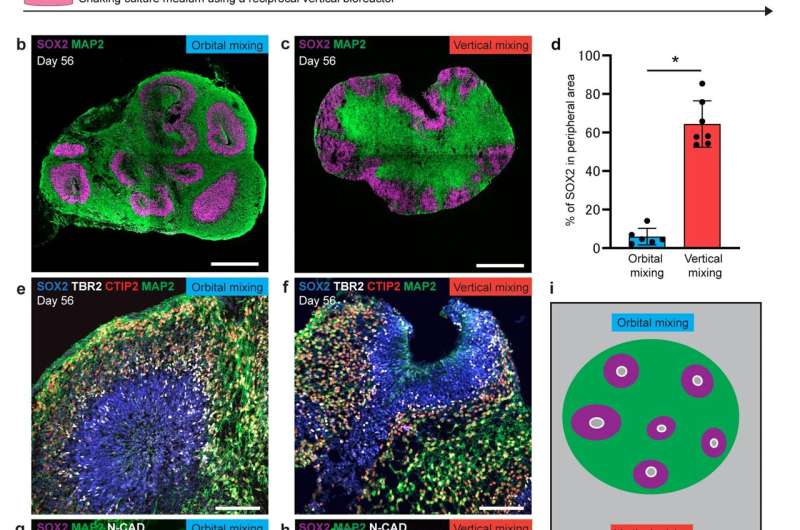Fig. 1: Brain organoid generated by vertical mixing showed inverted structure in comparison with brain organoid generated by orbital mixing. a Schematic diagram of conditions used to induce brain organoid by orbital mixing (upper schema) and by vertical mixing (lower schema). b, c Immunostaining for neural progenitor (SOX2, magenta) and neuron (MAP2, green) in brain organoid generated by orbital mixing (b) or vertical mixing (c) on Day 56. d Quantification of SOX2-positive area in the peripheral region of brain organoid on Day 56. The peripheral region was defined as 100 µm inside from the edge of brain organoid. Brain organoid from vertical mixing showed higher percentage of SOX2-positive area in peripheral region in comparison with brain organoid from orbital mixing. Data represent mean ± SD (n = 6 for brain organoids by orbital mixing, n = 7 for brain organoids by vertical mixing). Difference between the two conditions was analyzed by Student’s two-tailed t-test (*p < 0.0001). e, f Immunostaining for markers of neural progenitors (SOX2, blue), intermediate neural progenitors (TBR2, gray), and cortical neurons (CTIP2, red; MAP2, green) in brain organoids by orbital mixing (e) or vertical mixing (f) on Day 56. g, h Immunostaining for markers of ventricular neuroepithelial cells (N-CADHERIN: N-CAD, gray), neural progenitors (SOX2, magenta), and cortical neurons (MAP2, green) in brain organoids by orbital mixing (g) or vertical mixing (h) on Day 56. Note the apical side of organoids generated by orbital mixing is located inside organoids, while that of organoids generated by vertical mixing is located at the surface of organoids. i Schematic diagram shows the difference of brain organoids by orbital mixing and by vertical mixing. Scale bars = 500 µm (b, c), 100 µm (e, f), 50 µm (g, h). Credit: DOI: 10.1038/s42003-021-02719-5
Brain organoids are models of the brain made from growing stem cells like iPS cells into three-dimensional structures. They are used to study all sorts of brain-related phenomenon, including neural networks and disease development. However, a new study led by CiRA Professor Haruhisa Inoue, in collaboration with RIKEN and other organizations, shows how scientists mix the iPS cells will greatly influence the structure of the organoids. The paper was published online on October 22 in Communications Biology.
In general, organoids are prepared by orbital shaking of the cells, in which the fluid is flowed around an axis like a planet around the sun. The new study compared orbital shaking with vertical shaking, in which the fluid is pressed up and down like in a coffee press. Vertical shaking was previously found by other CiRA researchers to greatly increase the production of platelets by iPS cells, resulting in the world's first transfusion of platelets manufactured from iPS cells in a patient. Its effects on brain organoids, however, was unknown.
The vertical shaking resulted in what the researchers call "inverted brain organoids": in orbital shaking, neurons surrounded neural progenitor cells in the organoids, but in vertical shaking, the progenitor cells surrounded the neurons. Regardless, both organoids developed functional neural networks.
The different mixing conditions should result in different fluid dynamics on the cells. Indeed, a computational analysis of several fluid variables found that vertical mixing resulted in aggregates of iPS cells in the mixture equally dispersing, which was not the case with orbital mixing.
The different mixing effects were detected by the cilia of the cells, which act like the hairs on our bodies, but with the added importance of regulating how cells grow, migrate and pattern in tissues. However, the mixing influenced the direction to which the cilia pointed: in orbital mixing, the cilia pointed mostly in two directions, but in vertical mixing they pointed in multiple directions.
"The direction of the cilia suggests the fluid dynamics are detected differently by the organoids depending on the type of mixing," said Inoue.
Inoue added that the inversion also had an effect on a specific type of neuron.
"Both orbital and vertical mixing produced GABAergic neurons, but many more GABAergic neurons were seen with vertical mixing," he said.
Consistently, cells vertically mixed showed a higher expression for genes associated with GABAergic cells. Furthermore, past research has shown that cilia-related Sonic hedgehog signaling can influence the development of GABAergic neurons, again reiterating the influence of mixing on the organoid structure.
GABAergic neurons are of special interest to Inoue and his colleagues, because of their focus on Alzheimer's disease. Indeed, alterations in GABAergic neural circuits are believed to contribute to the disease. The study therefore prepared inverted brain organoids from the iPS cells of an Alzheimer's disease patient and found molecular hallmarks of the disease.
"We hope that by controlling the fluid dynamics, we can design organoid models of brain diseases," said Inoue.
More information: Dang Ngoc Anh Suong et al, Induction of inverted morphology in brain organoids by vertical-mixing bioreactors, Communications Biology (2021). DOI: 10.1038/s42003-021-02719-5
Journal information: Communications Biology
Provided by Kyoto University
























